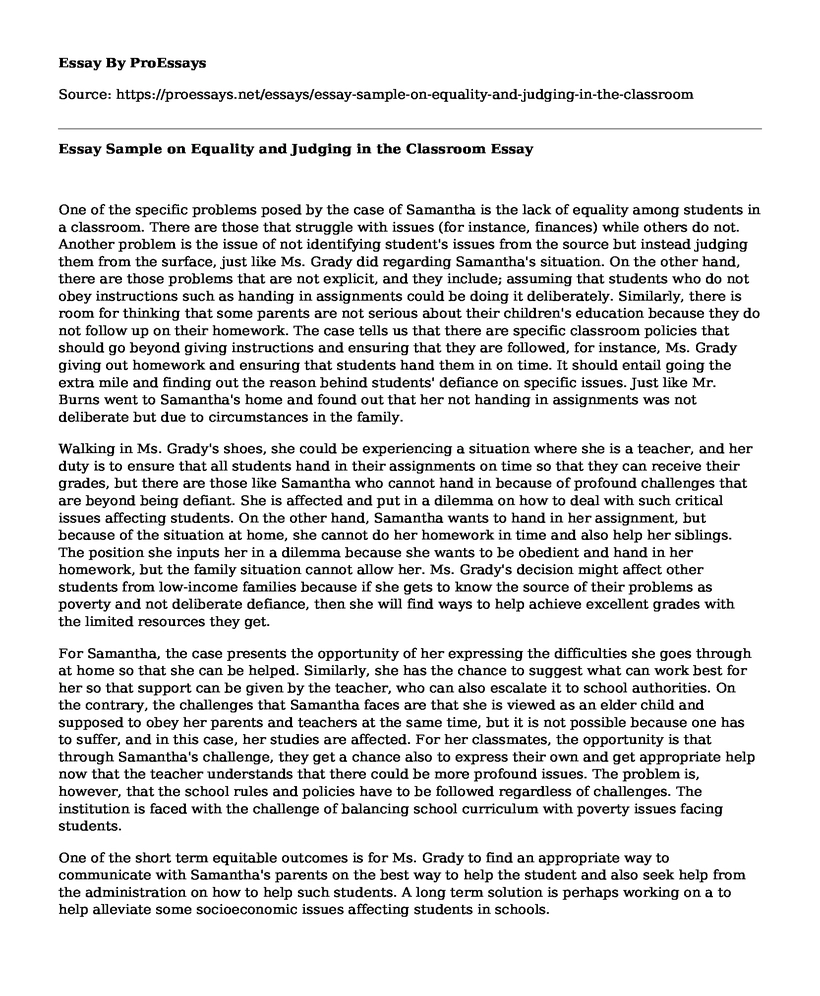One of the specific problems posed by the case of Samantha is the lack of equality among students in a classroom. There are those that struggle with issues (for instance, finances) while others do not. Another problem is the issue of not identifying student's issues from the source but instead judging them from the surface, just like Ms. Grady did regarding Samantha's situation. On the other hand, there are those problems that are not explicit, and they include; assuming that students who do not obey instructions such as handing in assignments could be doing it deliberately. Similarly, there is room for thinking that some parents are not serious about their children's education because they do not follow up on their homework. The case tells us that there are specific classroom policies that should go beyond giving instructions and ensuring that they are followed, for instance, Ms. Grady giving out homework and ensuring that students hand them in on time. It should entail going the extra mile and finding out the reason behind students' defiance on specific issues. Just like Mr. Burns went to Samantha's home and found out that her not handing in assignments was not deliberate but due to circumstances in the family.
Walking in Ms. Grady's shoes, she could be experiencing a situation where she is a teacher, and her duty is to ensure that all students hand in their assignments on time so that they can receive their grades, but there are those like Samantha who cannot hand in because of profound challenges that are beyond being defiant. She is affected and put in a dilemma on how to deal with such critical issues affecting students. On the other hand, Samantha wants to hand in her assignment, but because of the situation at home, she cannot do her homework in time and also help her siblings. The position she inputs her in a dilemma because she wants to be obedient and hand in her homework, but the family situation cannot allow her. Ms. Grady's decision might affect other students from low-income families because if she gets to know the source of their problems as poverty and not deliberate defiance, then she will find ways to help achieve excellent grades with the limited resources they get.
For Samantha, the case presents the opportunity of her expressing the difficulties she goes through at home so that she can be helped. Similarly, she has the chance to suggest what can work best for her so that support can be given by the teacher, who can also escalate it to school authorities. On the contrary, the challenges that Samantha faces are that she is viewed as an elder child and supposed to obey her parents and teachers at the same time, but it is not possible because one has to suffer, and in this case, her studies are affected. For her classmates, the opportunity is that through Samantha's challenge, they get a chance also to express their own and get appropriate help now that the teacher understands that there could be more profound issues. The problem is, however, that the school rules and policies have to be followed regardless of challenges. The institution is faced with the challenge of balancing school curriculum with poverty issues facing students.
One of the short term equitable outcomes is for Ms. Grady to find an appropriate way to communicate with Samantha's parents on the best way to help the student and also seek help from the administration on how to help such students. A long term solution is perhaps working on a to help alleviate some socioeconomic issues affecting students in schools.
In brainstorming the short term, responses are to write a letter to Samantha's parents to arrange for a meet up to deliberate on the issue and find solutions to helping the student balance between home and school work. An example is allowing Samantha to take remedial classes to enable her to finish homework while still at school.
The long-term solution will be to engage the school administration into looking at the matter of poverty-stricken students and finding a solution. A right way will be giving them assignments that can be done and handed in after a few days. Another way is to provide them with a scholarship which will be tagged with allowance to allow them to cater to specific financial needs and reduce parents' burden.
The action plan is to ensure that authorities are aware of the financial hardships of students in the school and allow for donations and funding through the local and federal state authorities. As a result, it will lighten the burn of parents and allow the affected students to focus more on their studies.
References
Baker, B. D. (2018). Educational Inequality and School Finance: Why Money Matters for America's Students. Harvard Education Press. 8 Story Street First Floor, Cambridge, MA 02138.
Lafortune, J., Rothstein, J., & Schanzenbach, D. W. (2018). School finance reform and the distribution of student achievement. American Economic Journal: Applied Economics, 10(2), 1-26.
Tindell, S., Young, L., O'Rear, E., & Morris, P. (2016). Teaching assistant perspectives on diversity and social justice education course for collegiate agriculture students. NACTA Journal, 60(2), 158.
Cite this page
Essay Sample on Equality and Judging in the Classroom. (2023, May 09). Retrieved from https://proessays.net/essays/essay-sample-on-equality-and-judging-in-the-classroom
If you are the original author of this essay and no longer wish to have it published on the ProEssays website, please click below to request its removal:
- What Does One Need to Make a Good Presentation?
- Postgraduate Dentistry Personal Statement
- Online Adult Education - Essay Sample
- Oppositional Defiant Disorder Trauma in Foster Children
- Paper Example on Creative Leadership: Understanding & Practicing Diversity
- Essay Example on Leadership in Healthcare Orgs: A Transformational Style
- Applying for Technology Specialist Position - Qualified SCCM Admin - Free Application Letter Sample







